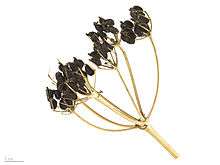Smyrnium olusatrum
Smyrnium olusatrum, common name Alexanders,[1] is an edible cultivated flowering plant of the family Apiaceae (or Umbelliferae).[2] It is also known as alisanders, horse parsley, and smyrnium. It was known to Theophrastus (9.1) and Pliny the Elder (N.H. 19.48).[3]
| Smyrnium olusatrum | |
|---|---|
| Scientific classification | |
| Kingdom: | Plantae |
| Clade: | Tracheophytes |
| Clade: | Angiosperms |
| Clade: | Eudicots |
| Clade: | Asterids |
| Order: | Apiales |
| Family: | Apiaceae |
| Genus: | Smyrnium |
| Species: | S. olusatrum |
| Binomial name | |
| Smyrnium olusatrum | |

Description
Alexanders is a stout biennial growing to 150 centimetres (59 in) high, with a solid stem which becomes hollow and grooved[4] with age. The leaves are bluntly toothed, the segments ternately divided the segments flat, not fleshy.[5]
Habitat
The plant is common on waste ground and field margins, especially near the sea, where it may also be found on cliff paths and near the shore.[6][7]
Distribution
Alexanders is native to continental Europe and has long been naturalised in Britain and Ireland where it is widely dispersed and - in addition to other disturbed habitats - commonly found on the sites of medieval monastery gardens as a persistent relic of former cultivation.[2] Irish localities include: Counties Down, Antrim and Londonderry and throughout most of Ireland.[6][8]
History
Alexanders is native to the Mediterranean but is able to thrive farther north.[2] It was a highly popular herb during the time of Alexander the Great.[9] The plant was introduced to the British Isles by the Romans, who called it the ‘pot herb of Alexandria.’
Culinary uses
Every part of the plant is edible. The flowers are yellow-green in colour and arranged in umbels,[4] and its fruits are black. It flowers from April to June.[4] Alexanders is intermediate in flavor between celery and parsley.[2] It was once used in many dishes, either blanched,[10] or not, but it has now been replaced by celery. The black seeds have a taste that has been described as both spicy or peppery.
They were used in medieval cuisine in place of a bitter type of celery. One 17th century text describes young shoots used in salads or a "vernal pottage" and an early 18th century recipe recorded by Caleb Threlkeld for Irish Lenten Potage includes alexanders, watercress and nettles. Alexanders fell out of favour in the 18th century after celery started being mass produced to replace wild herbs and vegetables. Alexanders are not commonly used as a food product in the modern era,[2] but have found some renewed use in exotic "foraged" food recipes and restaurants.
Look for this tall plant on cliff paths; the first seaside greenery of the year. Roman soldiers would carry the plant on long journeys, as they could eat the leaves, the stems, the roots, and the buds.[11]
Fodder plant
Alexanders is a feed source much appreciated by horses.
Medicinal use
The plant is used as traditional medicine in China.[12]
References
- "Smyrnium olusatrum". Natural Resources Conservation Service PLANTS Database. USDA. Retrieved 16 November 2015.
- Davidson, Alan, and Tom Jaine. The Oxford companion to food. Oxford University Press, USA, 2006. 805. Print.
- Pliny (1856). "Book XX. Anise—sixty-one remedies". The Natural History of Pliny. 4. translators John Bostock, Henry Riley. London: Henry Bohn. pp. 271–274. OCLC 504358830.
- Parnell, J. and Curtis, T. 2012. Webb's An Irish Flora. p.425 Cork University Press ISBN 978-185918-4783.
- Webb, D.A., Parnell, J. and Doogue, D. 1996. An Irish Flora. Dundalgan Press Ltd. Daldalk. ISBN 0-85221-131-7.
- Hackney, P.(Ed) 1992 Stewart and Corry's Flora of the North-east of Ireland. Institute of Irish Studies The Queen's University of Belfast. ISBN 0-85389-446-9.
- Clapham, A.R., Turin, T.G. and Warburg, E.F. 1968. Excursion Flora of the British Isles. Cambridge University Press. ISBN 0-521-04656-4.
- Scannell, M.P. and Synnott, D.M. 1972. Census Catalogue of the Flora of Ireland. Dublin Stationery Office.
- Sanderson, Helen; Renfrew, Jane M. (2005). Prance, Ghillean; Nesbitt, Mark (eds.). The Cultural History of Plants. Routledge. p. 113. ISBN 0415927463.
- MM. Vilmorin-Andrieux; W.Robinson. 1885/undated. The vegetable garden: Illustrations, descriptions, and culture of the garden vegetables of cold and temperate climates, English Edition. Jeavons-Leler Press and Ten Speed Press. 1920 edition in Internet Archive
- Ginn, Peter and Goodman, Ruth 2013. Tudor Monastery Farm. Random House (BBC Digital). ISBN 9781448141722.
- Jiaju Zhou; Guirong Xie; Xinjian Yan (2011). Encyclopedia of Traditional Chinese Medicines. 2. Springer. p. 101. doi:10.1007/978-3-642-16744-7. ISBN 978-3-642-16744-7. LCCN 2011922128.
| Wikisource has the text of the 1911 Encyclopædia Britannica article Alexanders. |